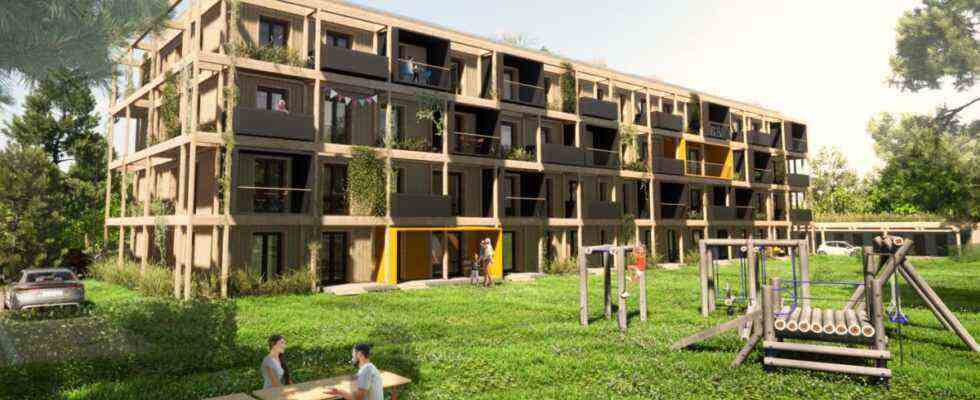It’s always something with the big vision. Anyone who has one is quickly labeled as a dreamer by many. But Ulf Bohne doesn’t seem to let this unsettle him, he simply sticks to his goal: Bohne wants to revolutionize building.
After all, the architect from Düsseldorf is convinced that the future of our planet is very much determined by planning and building, by architecture, urban development and housing. “But the way of building,” says Bohne, “hasn’t really changed anything fundamentally” since the 1950s – with all its dramatic consequences for the climate, environment, quality of life and resources.
Almost 40 percent of the CO₂-Emissions worldwide come from buildings. And when it comes to waste, construction waste alone makes up more than half of the total waste generated in Germany. “We urgently need a lot of new apartments, no question about it, but they have to be ecologically sound, economically affordable and of high quality,” says Bohne. “And that’s where we start with our company Imti.”
The key: the connection between the real and the digital world
During a cruise in the Mediterranean in the summer of 2018, Bohne spent hours plowing through extensive plastic waste carpets on the high seas with his recently acquired tall ship. “It disturbed me and woke me up,” he says.
“The construction industry had and still has little interest in groundbreaking changes. And why should they, they earn a lot of money with the status quo.” The fact that the architect finally got involved in a “rebellion” against the prevailing conditions in construction has a lot to do with his passion for technical and technological innovations.
Bohne was fascinated by how other industries have gone digital. Whether it’s the pharmaceutical industry, car or aircraft construction – almost all companies have embraced the idea of the “digital twin”, he says. A technology that creates a connection between the real and the digital world and makes it possible to optimally control product and life cycles. “In this way, closed material cycles can be created – from the initial idea for a product to its recycling,” says Bohne.
“The construction industry had and still has little interest in groundbreaking changes,” says Ulf Bohne.
(Photo: Lichterloh Light Rent/Imti)
He envisions digitizing the entire construction value chain. Roughly like this: Designing, simulating and testing the house and apartment on the computer, then converting this to fully automated production of building modules, finally monitoring and controlling the entire life cycle of the building after assembly, right through to the recycling of the materials that accumulate in a house that is ready for demolition . With Intelligent Modultecture Industries, or Imti for short, Bohne soon found a working title for his project.
“From planning to completion only months pass instead of years”
Coincidence brought him together with Sven Rickes at the end of 2019. The contractor had just taken over a disused factory site in Stadthagen near Hanover, which he wanted to convert into an industrial and commercial park. Rickes says that Bohne quickly convinced him of the idea of a digital factory for the construction industry. “And if it is realized, that was clear to me, then only here on my premises.” The two builders were soon joined by Boris Beckmann, a proven expert in digitization and corporate development. Finally, there was the architect André Pilling, whom Bohne had come to know and appreciate when Pilling worked as a student in his architecture office.
They founded Imti in May 2020, and half a year later they had not only won the first two investors, but also the first cooperation partner, Aachen Technical University (RWTH).
Bohne and Co. want to build quickly, profitably and climate-friendly with their digitized modular construction method, which has now been patented. “It takes months instead of years from planning to completion,” says Rickes. In addition to the reduced construction time, there are significantly lower costs: According to calculations by Imti, at least 20 percent cost savings are possible compared to conventional construction for the houses and apartments. The buildings themselves are essentially made of wood, while energy-intensive building materials such as steel or concrete are being replaced by renewable materials.
The delivery of the first 50 residential units has already been agreed
The building shell will be greened, photovoltaics installed on the roof will take over the power supply for the entire house and also supply excess electricity to e-car charging stations in front of the house. “Even if the building is in use, it can continue to change if necessary,” says Bohne.
At the end of October 2021, the Imti team took a first step into the real world of construction and presented the prototype of their living module “I’m One”. “In just a few months,” announces Bohne, production of the modules can start in their Stadthagen plant. Investors are now also ready to finance the approximately 100 million euro investment. In addition, the delivery of the first 50 residential units was contractually agreed with a West German municipality.
The opening of Bohne and his colleagues has triggered a proper echo in the construction industry. The founders now want to find out how seriously others are interested in getting involved. To their surprise, the Frenchman Alexandre Missoffe, who is looking for investors around the world to help solve the Paris housing problem, has also signed up.

